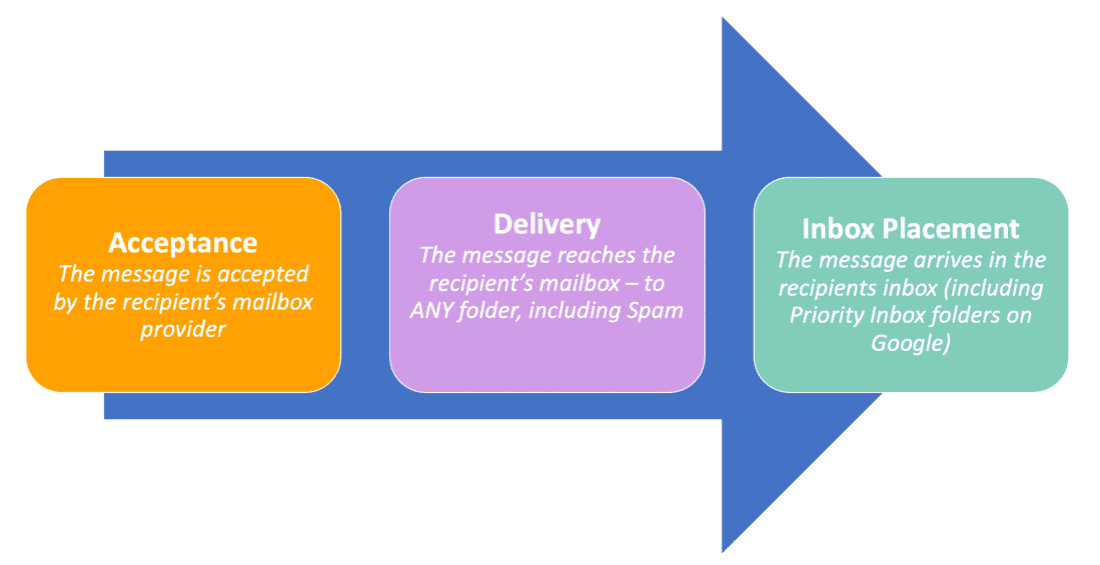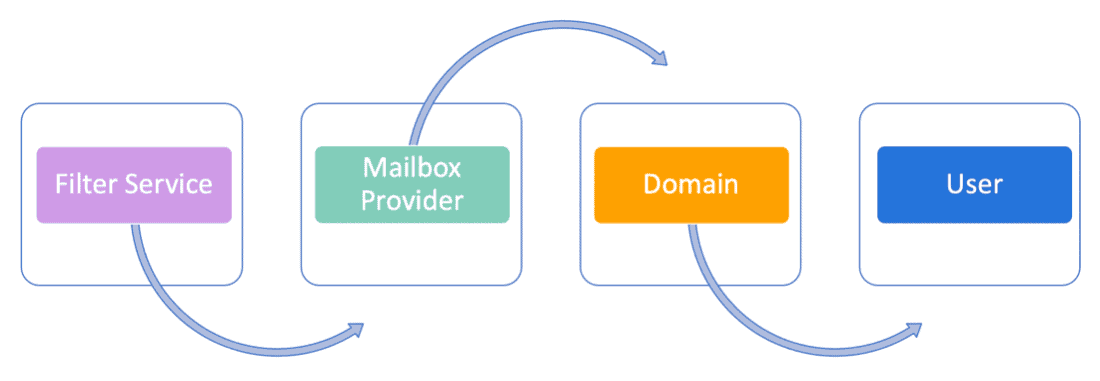Deliverability is absolutely critical to your email program and email monetization strategy. You may have the best segmentation and poured long hours into perfecting your content, but if you can’t get that email to the inbox, all of that work goes out the window. We’ll provide a breakdown of what deliverability is, how you can identify if you have a problem, and how you can work to avoid that dreaded spam folder.
What Is Email Deliverability?
Deliverability is all about making sure your emails reach your audiences’ inboxes. You can separate deliverability into 3 sections: Acceptance, Delivery, and Inbox Placement.

Identifying If You Have A Problem
You may have a problem if you are seeing a decrease in Opens and Clicks & Conversions and an increase in Bounces, Complaints, and Delays. A good way to be able to spot a problem is to monitor your stats to create a baseline of metrics of what a ‘good campaign’ looks like in terms of opens, clicks, bounces, and complaints. You can then compare all future sends to this baseline and will be able to quickly spot if a problem pops up.
Once you are able to discern that you have a problem, the next step is to locate where the problem is occurring. There are 4 categories of deliverability problems that can keep your email from reaching the inbox:
- Content
- Reputation
- Engagement
- Authentication
And then there are different areas within the delivery chain where an email send can be thwarted. Spam filters don’t live in one spot, and a message passes through many places where filtering can occur. When a user reports they didn’t receive a message, you’ll need to do some digging to see where specifically the filtering occurred.
First, there is the Filter Service (i.e. Mimecast, Proofpoint), a dedicated email security and spam filter that is commonly used by larger organizations. Second, there is the Mailbox Provider (i.e. Microsoft 365, Gmail) which is the company that hosts the recipient mailboxes. If the organization does not utilize a Filter Service, then the Mailbox Provider’s filters may be the first hurdle for senders and is also where engagement filtering occurs. Next is the Domain specific level filtering rules. This is where the organization introduces its own spam filter application (i.e. Barracuda, Sophos) or they tweak the dials for the Filter Service and Mailbox Provider to meet their specific needs; like blocking messages from certain domains or increasing the sensitivity of spam filtering in general. And finally, the User (i.e. Outlook, Thunderbird) can set their own spam filtering settings and may have even have other filtering applied unrelated to spam filtering that can cause a message to end up somewhere other than the inbox.

Digging Into The Problem
As mentioned above, there are 4 categories in which deliverability problems can occur. We’re going to dive into each category to provide you with the tools you need to determine if your program has an issue with one of these categories, and how to implement improvements.
Message Content
In general, ‘spammy’ content is no longer categorized as such just due to the use of ‘spammy phrases’. Content can be considered a problem if it uses previously reported spam, or contains links to poor reputation websites. Here are a few things to look for within your content to make sure you are not flagged as spam:
- Content that looks similar to known spam – Filters no longer use “spammy word” lists, although individual organizations and recipients may still choose to use them. Instead, pattern matching is used to see if a message looks similar enough to previously detected spam. Virus and security scanners operate at these levels.
- Suspicious attachments – Attachments are often scanned for viruses, but also password protected files or PDFs with executable content.
- Suspicious links – Link URLs get the most attention from spam filters these days. Link URLs that are not secure or lead to poor reputation websites will be flagged, along with URLs that have hidden redirects, that link to a password protected area, or have a different domain than the domain of the from address you used to send your message.
Sender Reputation
Sender reputation is the overall measure of how welcome a sender is in the inboxes of recipients. It is calculated using many factors that are often specific to the particular mailbox providers. It’s hard to determine what each mailbox provider uses to calculate sender reputation, and some providers, such as Google and Microsoft, actually hide how they calculate sender reputation to deter attempts to outsmart the filters. The good news is you control your reputation, so you can take steps to better your reputation over time!
Although some providers don’t detail the specific factors they use to calculate sender reputation, we do know the below factors are universal in influencing reputation:
- Spam Complaints: Subscribers clicking the spam button on your messages
- Invalid Email Address: Density of abandoned email addresses on a sender’s list
- Spam Traps: Booby-trapped email addresses that don’t belong to an active user used to identify illegitimate senders with poor list hygiene practices
- Blocklists: Listing of a domain or IP address that has been determined to be a source of spam
- Subscriber Engagement: Measure to determine the recency of opens, clicks, or any other positive or negative actions from subscribers
With the above factors playing a key role in sender reputation, it is important that you avoid buying or renting email lists, sending unsolicited/unwanted messages, and poor list hygiene.
Engagement
Engagement is how the recipient interacts with your email. Engagement filters are used to analyze the behavior of recipients to determine if a message or sender is good or bad. They work both in real time and use historical analysis.
Positive interactions can be: opening, replying, marking as ‘not spam’, creating a message rule, and adding sender to address book. All of these things indicate to providers that the messages are wanted and should be sent to the inbox. Negative interactions can be: marking as ‘spam’, deleting without reading, and manually adding to spam list. All of these actions indicate to providers that the messages are not wanted.
With all of this in mind, you need to create content that is targeted towards your audience and will lead to positive engagement. Here are three pillars that will help you target positive engagement:
- Have something to say. Only send an email if there is an explicit purpose and segment your audience to make sure you are sending relevant content to the right people.
- Think about your audience. Not only should you ensure the message is readable and accessible, but you also need to think about cadence. Don’t flood your audiences’ inboxes, as this could lead to fatigue and cause them to opt out, or worse, mark as spam. And speaking of opting out, make sure it is easy to unsubscribe from your emails, as the only other option your audience will have is sending your messages to the spam/junk folder.
- Don’t give reason to disengage. First and foremost, make sure you have explicit consent to send emails to your users. Do not, for example, sign them up for your newsletter if they’ve only opted in to receive offers emails. Users need to opt-in explicitly to your newsletter before you start sending to them. Also, make sure you are not sending the same content to the same recipients more than once. This can cause frustration and email fatigue, which can lead to your emails being marked as spam.
Email Authentication
Email authentication is comprised of three internet protocols that help senders identify their mail streams, and this in turn allows senders reduce the risk of being falsely identified as spam and increases the ability to spot if your domain is being spoofed. These three protocols are SPF, DKIM, and DMARC.
- SPF (Sender Policy Framework)
SPF, in short, is a list of email servers or computer networks that are allowed to put a particular domain name in the return-path. The return-path is the email address added by the sending email server which tells receivers where to send any bounces. It is needed because the sending server has no way of knowing whether the recipient email address is valid. When a receiving server gets a message for an undeliverable email address, they will send the bounce notification back to whatever address is identified in the return-path.
SPF is pretty much a requirement these days, so it is important to know this protocol. If you are utilizing an Upland product like PostUp or Adestra, Upland most likely manages your SPF since we set the return-path so that we can track bounces.
- DKIM (DomainKeys Identified Mail)
DKIM is a way to use cryptography to associate an email message with a domain. A DKIM aware sender will DKIM sign outgoing messages for the receiver to verify. In more detail, the sending email server (Adestra/Post Up) creates a public/private key-pair. The private key is stored on the sending server, and the public key is stored in the sender’s DNS. The sending server uses the private key to create a verifiable cryptographic hash of each outgoing the message. The receiving server uses the public key to verify if the hash is valid. An invalid hash means the message may have been tampered with en-route, and the DKIM test will fail.
DKIM is actually far more important than SPF in the way of deliverability because DKIM allows reputation systems to associate DKIM signatures with message streams.
- DMARC (Domain Message Authentication, Reporting, and Conformance)
DMARC essentially puts a policy layer on top of SPF and DKIM. It is a method used to reduce spoofing of the domain in the From address by allowing domain owners (senders) to authorize who can use their domain in the From address of an email and publishes a policy (in DNS) suggesting to email receivers how they should handle emails which fail DMARC tests. DMARC also requires that the From domain, the return-path domain, and the DKIM signing domain are all aligned (i.e. they all match).
However, you should keep in mind that DMARC was never intended to be used in marketing messages. When you deploy DMARC, you are telling mailbox providers to reject messages that don’t comply with DMARC’s alignment requirements. If set up DMARC incorrectly, you can inadvertently cause deliverability problems for yourself. So, you should not use DMARC unless you are certain you know how to properly set it up.
Here are some final notes for email authentication:
- Align your DKIM domain with your From domain
- Make sure SPF is set up correctly
- Don’t use DMARC unless you really know what you’re doing
How To Avoid The Spam Folder
Now, let’s put everything together. We know that deliverability problems are typically caused by poor sender reputation, a content issue, or improperly configured email authentication. Following the below steps can take all that we’ve learned above and help you to create a strategy what should allow you to avoid the dreaded spam folder.
Step 1: Authentication – Get your DKIM aligned, make sure SPF is working, and don’t use DMARC unless you know what you’re doing.
Step 2: Track Your Stats – High bounce rates suggest you’re working with outdated contact lists, and high complaint levels will affect your sending reputation.
Step 3: Easy to Unsubscribe – When a recipient can’t easily unsubscribe, they’ll often mark the email as spam instead, which will affect your sending reputation.
Step 4: Send to Active Users – High open and click rates are great for your reputation. You can increase engagement rates by sending to those who have read your emails in the last 30 or 60 days.
Step 5: Segment Your Emails – Rather than sending mass emails to your entire list, segment your content and make it relevant to your subscribers’ interests.
Step 6: Track Reputation – A number of tools exist for you to track your reputation and identify why your reputation might be decreasing
Step 7: Check Blocklists – Blocklisting happens when the domain or IP is known for sending a lot of spam. If you’re on a shared IP address, you could be affected by other businesses’ sending practices, so keep any on blocklists.
Step 8: Keep Lists Clean – Maintain a list of subscribers that haven’t previously unsubscribed, complained, bounced, or become inactive.
Step 9: Avoid Spam Traps – These fake email addresses will often appear on bought lists.
Step 10: Use Seed Accounts – Test your email campaign with certain seed accounts on various domains to get a broad view of how your email will perform on inbox placement.
Step 11: HTML Best Practice – Keep up-to-date with HTML best practices. Use clean code, clear subject lines, don’t bait your users with leading or vague syntax, and adhere to image to text ratio guidelines.
Step 12: Be Transparent – When users are signing up or opting in, always disclose what their email address will be used for, and what communications they will be receiving.
